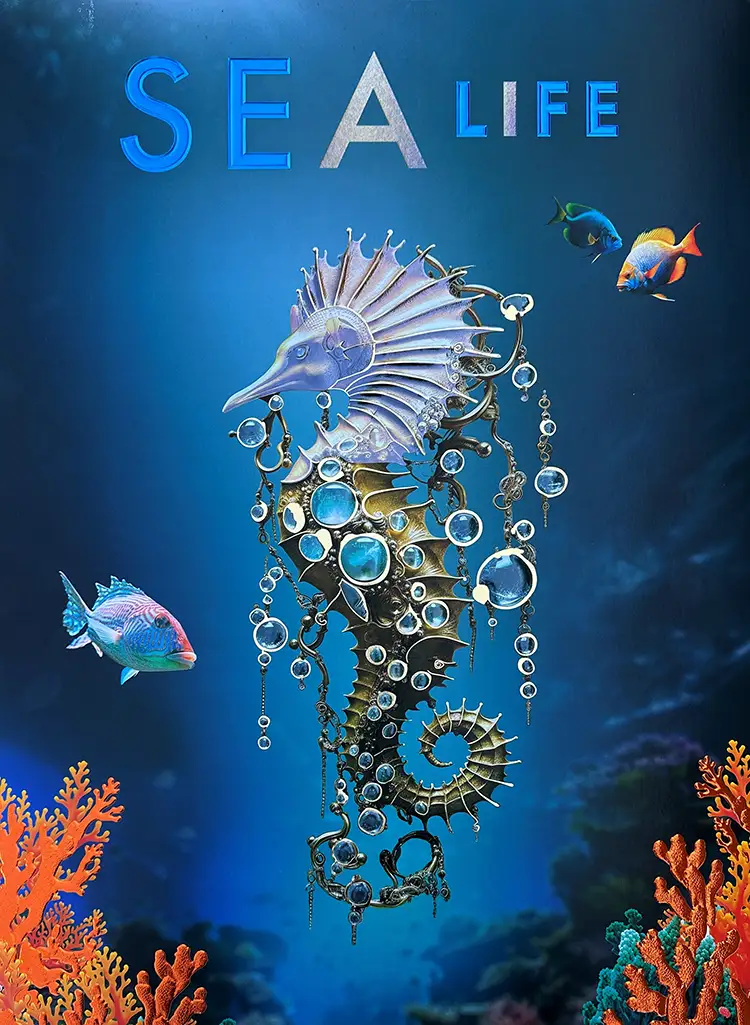
Edited by Erin La Row, writer, PostPress
An annual project became an award-winning piece of art for the team at Hinderer + Mühlich (H+M), based in Göppingen, Germany, with a US facility in Charlotte, North Carolina. “Sea Life” merged artificial intelligence (AI) with print embellishment to create an eye-catching undersea adventure on paper. The poster, anchored by an embellished sea horse, captivated the judges at the Foil & Specialty Effects Association’s 31st annual Gold Leaf Awards, where the project won Best of Show: Best Use of Foil & Embossing.
Heike Martetschläger, marketing and design manager, said the poster first began as a project to decorate the cover of Verpackungsrundschau, a German packaging magazine. H+M used the opportunity to bring together a team of specialists in each involved area of the project (paper, foil, stamping dies, machinery) to show outstanding embellishment and give inspiration to designers and brand owners. The final cover design then was turned into a large poster. The magazine is not on the market anymore, but H+M continues the tradition of the poster, large and small. Sea Life is the 17th edition of its posters, and the team already is working on number 18.
“In our posters, we incorporate current trends in fashion, design or social trends and transform them into embossed designs,” Martetschläger said. “In doing so, we continually push the limits to showcase the exceptional potential of H+M stamping dies. We also use this project to underline our capacity for innovation and expertise.”
What sets apart Sea Life from the other posters is that its artwork was created using AI. The team used ChatGPT to formulate prompts for MidJourney, a text-to-picture AI tool, to generate imagery. The team wanted to see and experience for itself if there is more than mere functionality to AI – exploring the creative potential of AI. While brainstorming, Wohlgemuth & Company, the design agency behind the poster, suggested taking the AI experience a level higher and starting a collaboration between ChatGPT and MidJourney.
“We used ChatGPT to formulate prompts for MidJourney, swiftly generating around 300 images. Precision in prompt wording proved crucial, guiding the AI to meet our creative vision. Our approach merged fashion, design and jewelry with an underwater theme, prioritizing visual impact over realism,” Martetschläger said.
While Midjourney produced astonishingly realistic results, occasionally it resulted in flaws. “Embracing AI presents an opportunity to learn and innovate, despite occasional quirks like six fingers or peculiar facial features,” Martetschläger added. But with the speed of improvements in AI tools, Martetschläger said she believes the flaws in their process now would be reduced.
With the design determined, the team set out to create the final product. David Bohne, general manager at H+M USA, said, “The poster was designed to combine various visual and tactile styles, such as nanoembossing, microembossing and textured embossing. The big posters were printed on Algro Design Advanced 315 gm while the small poster was made on Algro Design Duo 250 gr – both by Sappi. Details and respective art files for the various foil and embossed elements were meticulously created for H+M to produce the highest quality and precision brass dies for this project, and then stamped and embossed on a Gietz FSA 720 foil stamping press.”
To create the larger Sea Life poster, there was a total of six passes on the Gietz foil stamping press. This included several flat stamp passes of foils, nanoembossing and customized texture in the top Sea Life headline, and a final intricate sculptured embossing of the sea horse. The gems on the sea horse were created with a combination of a clear foil and round embossing.
Art is subjective. The effectiveness of the previous posters depended on the audience – some people related to the design while others didn’t, Martetschläger said, adding there is a lot of interest in the story behind the project and the use of AI to get the design. “Sea Life is one of the designs in recent years that created interest and positive feedback from almost everybody – especially when people get to hold it in their hands,” Martetschläger said. “We even received pictures of customers showing where they had hung it up at their workplaces and their homes.”

